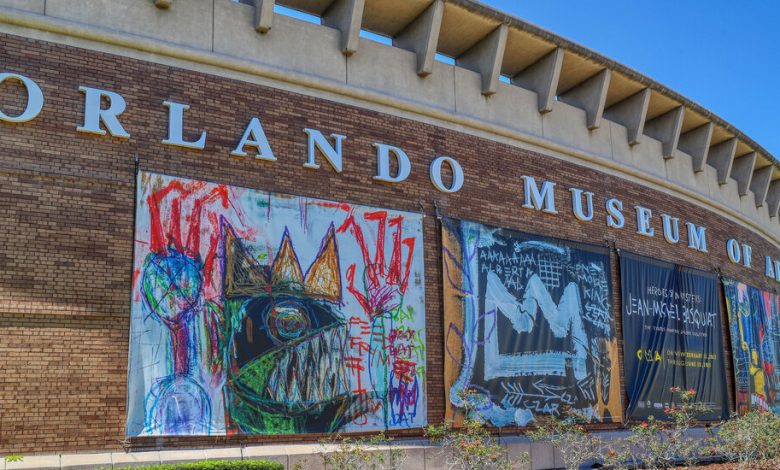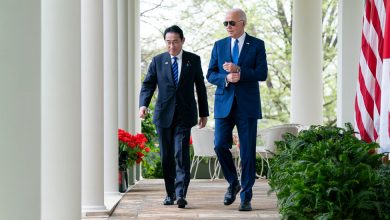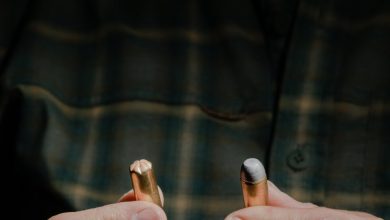Orlando Museum Accuses Ex-Leader of Seeking Profit From Fake Basquiats

The Orlando Museum of Art filed a lawsuit on Monday accusing its former director of seeking to profit from a scheme to show fake paintings that the museum had exhibited as newly discovered works by the celebrated artist Jean-Michel Basquiat, saying that the owners of the paintings had promised him “a significant cut of the proceeds” from their eventual sale.
The lawsuit also named five co-owners of those paintings who were said to have enlisted the former museum leader, Aaron De Groft, in a plan that lawyers said would advance “his own economic and personal interests” by leveraging the museum’s reputation to legitimize the fraudulent paintings and increase their value. De Groft has denied wrongdoing.
Lawyers for the museum say in the court papers that they are seeking an unspecified sum in damages for fraud, conspiracy, breach of fiduciary duty and breach of contract.
“The story of how the paintings ended up on the walls of O.M.A. is a truth stranger than fiction,” said the lawsuit, which was filed in circuit court in Florida. “O.M.A. spent hundreds of thousands of dollars — and unwittingly staked its reputation — on exhibiting the now-admittedly fake paintings. Consequently, cleaning up the aftermath created by the defendants has cost O.M.A. even more.”
“Its 99-year legacy,” lawyers for the museum wrote, “was shattered.”
After months of offering few public comments about the case, the lawsuit represents a shift by the museum to a more aggressive approach as it seeks to distance itself from De Groft and the Basquiat scandal that has upended the institution. In a statement on Tuesday, the museum’s current board chair, Mark Elliott, said the lawsuit “seeks to hold responsible the people the museum believes knowingly misrepresented the works’ authenticity and provenance.”
Following a report by The New York Times in February 2022 that raised questions about the authenticity of the Basquiats the museum planned to exhibit, the F.B.I. raided the museum and seized the paintings in question. The museum fired De Groft days after the raid and was later placed on probation by the American Alliance of Museums.
Then, as part of a plea deal in April 2023, a Los Angeles auctioneer admitted to helping create the fake artworks. The plea by the auctioneer, Michael Barzman — whose court documents detailed that some of the fake Basquiats had been created in as little as five minutes — was noted in Monday’s filing.
A spokeswoman for the F.B.I. declined to comment on the litigation but said its investigation was ongoing.
The court papers cite emails and text messages in which De Groft appears to make reference to the impending sale of the artworks. The filing includes a 2022 email that it says De Groft sent to the owner of a Titian, set to be exhibited at O.M.A., in which he wrote:
Reached at his Orlando home, De Groft said he had yet to be served with the lawsuit but denied that he had ever been promised any kind of sales commission by the owners of the 25 Basquiats or any other artworks.
“I categorically deny it,” he said of having any financial arrangement with those owners.
Asked specifically about the 2022 email cited in the lawsuit, and his demand for “30 percent,” he added: “The only thing that I remember that they said, more sort of casually, was that maybe we can make a gift to the museum at some point in the future to help repay the hundreds of thousands of dollars the museum spent on insurance, shipping, framing, publishing the catalog and everything else. But that was to go to the museum, not to me.”
De Groft and two of the other listed defendants, Pierce O’Donnell and Leo Mangan, both owners of the Basquiats, similarly maintained that the works were genuine and that Barzman was lying when he told federal agents he was the one who made the paintings, with an accomplice.
“We loaned the paintings for no fee,” said O’Donnell, a co-owner of six of the 25 Basquiats. He called the lawsuit “false and defamatory.”
Mangan, the owner of 19 of the Basquiats, said the lawsuit was an act of “requiem” because the museum was “at a loss of how to handle the situation,” adding that “there was no monetary remuneration in any direction.”
The 359-page filing, which contains dozens of exhibits, offers up a detailed timeline of events as recounted by lawyers for the museum, bolstered by emails and other written correspondence by De Groft and other named defendants. In the court documents, the museum alleges that De Groft had sought to use it as a vehicle to authenticate and sell not only the 25 Basquiats, but also paintings of hazy provenances purportedly by Titian and Jackson Pollock.
The lawsuit said De Groft had agreed to exhibit the Basquiats before ever seeing them in person and traveled to personally inspect them only three months before the museum’s exhibition was originally scheduled to open. “De Groft was presented with one red flag after another,” the lawsuit said, “warranting, at the very least, both reconsideration of the exhibition and disclosure to the O.M.A. board at large.”
In numerous cases, the lawsuit said, museum employees had raised concerns about the authenticity of the Basquiats, but those concerns were largely dismissed by De Groft.
The lawsuit said that after The Times published its article raising questions about whether the paintings were really by Basquiat — noting that a piece of cardboard from one painting bore a FedEx typeface that was not used until after Basquiat’s death — the museum’s board voted to end the exhibition early. The suit also said that the full board had not been aware that the F.B.I. was investigating the works until The Times reported on its inquiry in May 2022, saying that the board members had been “deprived of this information by De Groft for almost a year.”
Although the narrative outlined in the court papers by museum lawyers seeks to lay much of the blame at the feet of De Groft, The Times previously reported that the chairwoman of the board at the time, Cynthia Brumback, was also aware for months that the museum had been subpoenaed by the F.B.I., but had chosen to keep that knowledge under wraps; Brumback had also told staffers to defer to De Groft with their concern about the authenticity of artworks. She declined to comment about the lawsuit on Tuesday.
“It will take O.M.A. decades of work to rebuild its standing, recover donors and repair the damage defendants have caused,” the lawsuit said, “if doing so is even possible.”
Kirsten Noyes contributed research.





